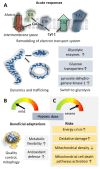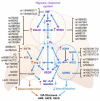Molecular Mechanisms of High-Altitude Acclimatization
- PMID: 36675214
- PMCID: PMC9866500
- DOI: 10.3390/ijms24021698
Molecular Mechanisms of High-Altitude Acclimatization
Abstract
High-altitude illnesses (HAIs) result from acute exposure to high altitude/hypoxia. Numerous molecular mechanisms affect appropriate acclimatization to hypobaric and/or normobaric hypoxia and curtail the development of HAIs. The understanding of these mechanisms is essential to optimize hypoxic acclimatization for efficient prophylaxis and treatment of HAIs. This review aims to link outcomes of molecular mechanisms to either adverse effects of acute high-altitude/hypoxia exposure or the developing tolerance with acclimatization. After summarizing systemic physiological responses to acute high-altitude exposure, the associated acclimatization, and the epidemiology and pathophysiology of various HAIs, the article focuses on molecular adjustments and maladjustments during acute exposure and acclimatization to high altitude/hypoxia. Pivotal modifying mechanisms include molecular responses orchestrated by transcription factors, most notably hypoxia inducible factors, and reciprocal effects on mitochondrial functions and REDOX homeostasis. In addition, discussed are genetic factors and the resultant proteomic profiles determining these hypoxia-modifying mechanisms culminating in successful high-altitude acclimatization. Lastly, the article discusses practical considerations related to the molecular aspects of acclimatization and altitude training strategies.
Keywords: acclimatization; altitude; genes; hypoxia; mitochondria; oxidative stress; redox homeostasis.
Conflict of interest statement
The authors declare no conflict of interest.
Figures




References
Publication types
MeSH terms
LinkOut - more resources
Full Text Sources

